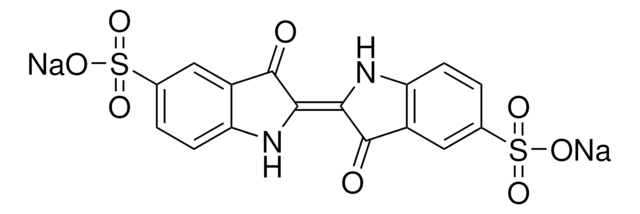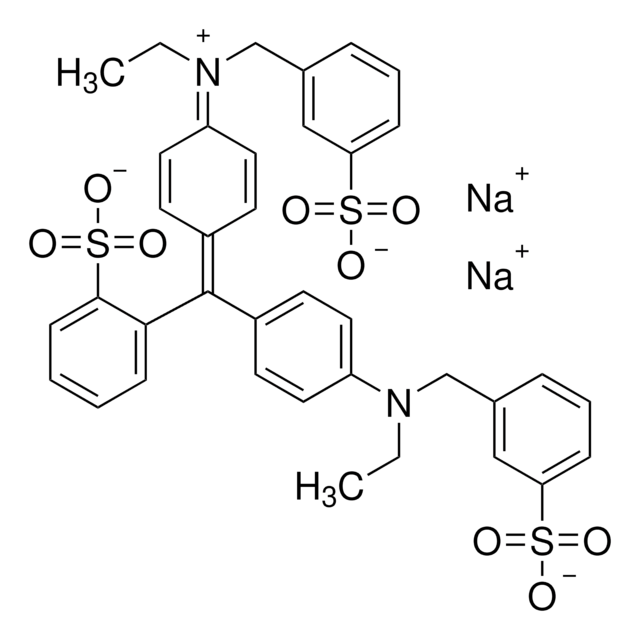81240
Poli(etilenoglicol)
average Mn 4,000, hydroxyl
Sinônimo(s):
PEG
Faça loginpara ver os preços organizacionais e de contrato
About This Item
Fórmula linear:
H(OCH2CH2)nOH
Número CAS:
Número MDL:
Código UNSPSC:
12352104
ID de substância PubChem:
NACRES:
NA.23
Produtos recomendados
Nome do produto
Poli(etilenoglicol), average Mn 4,000, platelets
fonte biológica
platelets
Nível de qualidade
Formulário
powder
peso molecular
Mn 3,500-4,500
average Mn 4,000
pf
58-61 °C
Ω-final
hydroxyl
α-final
hydroxyl
cadeia de caracteres SMILES
C(CO)O
InChI
1S/C2H6O2/c3-1-2-4/h3-4H,1-2H2
chave InChI
LYCAIKOWRPUZTN-UHFFFAOYSA-N
Procurando produtos similares? Visita Guia de comparação de produtos
Categorias relacionadas
Descrição geral
Polyethylene glycol (PEG) is a hydrophilic polymer. It can be easily synthesized by the anionic ring opening polymerization of ethylene oxide, into a range molecular weights and variety of end groups. When crosslinked into networks PEG can have high water content, forming “hydrogels PEG is a suitable material for biological applications because it does not trigger an immune response.
Aplicação
Polyethylene glycol (PEG) platelets were used:
- in PEG-directed gene delivery of protoplast transfection and incubation
- to prepare extraction for measuring cytosolic phosphoenolpyruvate carboxykinase (PEPCK) from plant tissues
- as DNA transformation agent in a study of transient gene expression of plant protoplasts, derived from rice leaf sheaths.
- in preparing isothermal assembly buffer and TSS broth preparation for unique nucleotide sequence (UNS)-guided assembly of repetitive DNA parts
- in transformation of DNA into log-phase cells of the budding yeast Saccharomyces cerevisiae.
- as DNA transformation reagent
Outras notas
Polymer networks with grafted cell adhesion peptides for highly biospecific cell adhesive substrates
Código de classe de armazenamento
11 - Combustible Solids
Classe de risco de água (WGK)
WGK 1
Ponto de fulgor (°F)
Not applicable
Ponto de fulgor (°C)
Not applicable
Equipamento de proteção individual
Eyeshields, Gloves, type N95 (US)
Escolha uma das versões mais recentes:
Já possui este produto?
Encontre a documentação dos produtos que você adquiriu recentemente na biblioteca de documentos.
Os clientes também visualizaram
Oleg Raitskin et al.
PloS one, 14(2), e0211598-e0211598 (2019-02-28)
Molecular tools adapted from bacterial CRISPR (Clustered Regulatory Interspaced Short Palindromic Repeats) systems for adaptive immunity have become widely used for plant genome engineering, both to investigate gene functions and to engineer desirable traits. A number of different Cas (CRISPR-associated)
Shen, Jinbo, et al. "Isolation, culture, and transient transformation of plant protoplasts
Shen J, et al.
Current Protocols in Cell Biology, 2014, 2-8 null
A simple and effective method to encapsulate tobacco mesophyll protoplasts to maintain cell viability
Lei R, et al.
Methods, 24-32 (2015)
Jennifer DeMars Tripp et al.
Yeast (Chichester, England), 30(5), 191-200 (2013-03-14)
Chemical-based methods have been developed for transformation of DNA into log-phase cells of the budding yeast Saccharomyces cerevisiae with high efficiency. Transformation of early stationary-phase cells, e.g. cells grown in overnight liquid cultures or as colonies on plates, is less
Frédéric Sanchez et al.
Genes, 10(5) (2019-05-28)
Ostreococcustauri is an easily cultured representative of unicellular algae (class Mamiellophyceae) that abound in oceans worldwide. Eight complete 13-22 Mb genomes of phylogenetically divergent species within this class are available, and their DNA sequences are nearly always present in metagenomic
Nossa equipe de cientistas tem experiência em todas as áreas de pesquisa, incluindo Life Sciences, ciência de materiais, síntese química, cromatografia, química analítica e muitas outras.
Entre em contato com a assistência técnica




